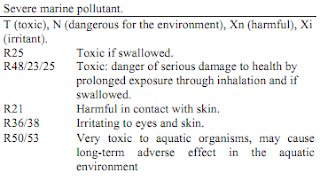Fat and Impotent Due to Tributyltin? Not Adipogenetic or Estrogenic, But Adipogenic and Estrogenic. Organotin TBT Dose-Dependently Increases Fat Deposition and Estrogen Receptor Activity.
 |
| Image 1: Chemical structure of tributyltin; the organotin is a common ingredient in pesticides, anti-fungals and marine paints |
Although large parts of the industry won't concede to it, many of the invisible pollutants of our "post-industrial" age are just as, or even more dangerous than the nasty air and water pollutants of the Industrial Revolution. One of these invisible killers is the organotin, tributyltin (TBT). It has been long established that TBT exposure during fetal life promotes adipogenesis and predispositions to a multitude of health problems in later life (Grün and Blumberg, 2006). Other than in other environmental toxins, such as Bisphenol A, it has been established only very recently that TBT may act as an estrogen receptor agonist, as well - in fact, in previous (low-dose) studies (Lissimachou. 2006; Mortensen. 2007; Zhang. 2009) the exact opposite appeared to be the case.
More importantly, these new results show that both effects, adipogenicity and estrogenicity, are not restricted to the prenatal phase (Penza. 2011), so that your daily exposure to tributyltin chloride via marine and fresh water pollution (cf. Antizar-Ladislao, 2008) may well be making you fat, impotent and infertile.
These new insights come from a group of European scientists, who were the first to evaluate the effects of various doses (mean human exposure to TBT: 0.5µg/kg; high dose: 50-500µg/kg) of tributyltin on peripubertal and sexually mature mice. What Penza et al. found were pronounced and highly sex- and dose-dependent increases in adipose tissue differentiation and estrogen receptor activity:
In view of the role the endocrine (hormonal) environment plays not only in the maturation of pre-adipocytes, but rather any aspect of the human metabolism, it would be short-sighted to observe the estrogenic and adipogenic effects distinctly. It is much more likely that the same biochemical processes are at the heart of both the estrogenic and adipogenic effects of TBT exposure and - what's even more important - regardless of your sex, you certainly want to avoid both!
Note: TBT has been banned from paints in the European Union since 2003, has been added to the United Nations global trade "watch list" by all 120 countries party to the Rotterdam Convention in 2004 and was eventually banned in the US, as well, in 2008. Unfortunately, the results of Antizar-Ladislao et al. suggest that its concentration in marine and freshwater ecosystems (accumulation in sediments) is still exceeding toxicity levels (Antizar-Ladislao, 2008).
More importantly, these new results show that both effects, adipogenicity and estrogenicity, are not restricted to the prenatal phase (Penza. 2011), so that your daily exposure to tributyltin chloride via marine and fresh water pollution (cf. Antizar-Ladislao, 2008) may well be making you fat, impotent and infertile.
 |
| Table 1: Information about TBT from supplemental material to the United Nations Convention in Rotterdam (UN. 2004) |
[...] the environmental organotin tributyltin chloride (TBT) exerts adipogenic action when peripubertal and sexually mature mice are exposed to the chemical. The duration and extent of these effects depend on the sex and on the dose of the compound, and the effects are relevant at doses close to the estimated human intake (0.5 μg/kg). At higher doses (50–500 μg/kg), TBT also activated estrogen receptors (ERs) in adipose cells in vitro and in vivo.
 |
| Image 2: Eco-activists from Greenpeace have long been aware of the dangers of TBT poisoning due to its accumulation in fresh and marine waters and sediments (photo by Marina Dimova. 2008) |
Note: TBT has been banned from paints in the European Union since 2003, has been added to the United Nations global trade "watch list" by all 120 countries party to the Rotterdam Convention in 2004 and was eventually banned in the US, as well, in 2008. Unfortunately, the results of Antizar-Ladislao et al. suggest that its concentration in marine and freshwater ecosystems (accumulation in sediments) is still exceeding toxicity levels (Antizar-Ladislao, 2008).


